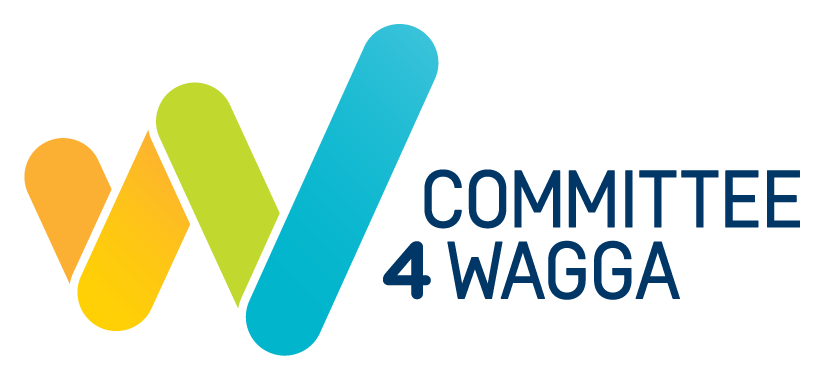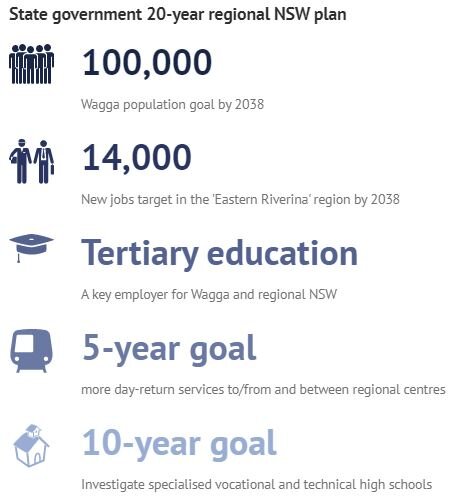Regional NSW plan identifies Wagga as area of 'significant growth' set for 100,000 residents under a 20-year goal
Daily Advertiser 5th August 2018
The state government has identified Wagga as an area of "significant growth" that will swell to 100,000 residents under its new 20-year plan for regional NSW. Under the plan released this week, titled 'A 20-Year Economic Vision for Regional NSW', the government placed Coolamon, Junee, Lockhart, Wagga council areas into an 'Eastern Riverina' region.
Wagga has already created the housing zones needed to meet the 100,000-resident target according to Garry Salvestro, a director of Wagga firm Salvestro Planning. "Wagga is already well-positioned to accommodate that as the strategy for growth in the city was done ages ago," Mr Salvestro said. Mr Salvestro said a big push in the 1970s for decentralisation by state and federal governments had first prompted Wagga's council to draw up plans for growth. "Under the planning, the bulk of the city will obviously be general housing suburban-type blocks, but there's a fair percentage of higher density development and it will take into account (semi-residential farmland)," Mr Salvestro said.
The Eastern Riverina 'functional economic region' would have to create 14,000 additional jobs by 2038 in order to support a Wagga regional city with 100,000 people. "Populations are rapidly increasing as people migrate to regional cities such as Bathurst, Orange, Tamworth, Dubbo, Lismore, Wagga Wagga and Coffs Harbour, attracted by their lifestyles and employment industries," the plan stated. "The hubs in Growth Centres typically provide sophisticated health, education and cultural services to surrounding Inland areas."
The plan identifies Eastern Riverina as one of the fastest growing NSW regions, with the Hunter, Central Coast and Lake Macquarie regions ahead with a predicted 30,000 to 57,000 new jobs by 2038. Regions like Albury-Wodonga and Shoalhaven were predicted to have similar 20-year jobs growth to Eastern Riverina.
The average population growth rate in the seven regional cities identified, including Wagga, has been at one per cent per year between 2006 and 2016. With Wagga's current population of about 64,000 people, it would need a growth rate of 2.1 per cent per year to exceed 100,000 people by the year 2038.
Wagga's growth rate has varied between 0.59 and 1.23 per cent in the five years to 2017, according to the Australian Bureau of Statistics, and Wagga City Council has predicted at 1.9 per cent growth rate over the next 13 years. "The largest growth rates will be in and around Wagga Wagga, Albury, Nowra-Bomaderry, Port Macquarie-Hastings, Tamworth and the Northern Rivers," the plan stated. "These places will particularly benefit from growth in population-serving sectors that will drive rises in living standards and contribute to more vibrant communities."
Wagga mayor Greg Conkey said he believed the region could meet the 100,000 population and 14,000 new jobs goal. "With the new airport going into Badgerys Creek, there are a number of industries affected and we believe the city of Wagga is very well located to capitalise as those businesses move into regional areas," he said. Cr Conkey said Wagga had a number of industries highlighted in the 20-year plan as priority spending areas for $4.2 billion from the Snowy Mountains Hydro Scheme buy-out.
"It will be even more exciting time for the city once that money starts to flow," he said. Cr Conkey said Wagga would likely remain dependent on overseas migration for a significant amount of its growth. "About 60 per cent of people who arrived in the city in the past five years have been people from overseas; that's refugees and skilled migrants as well," he said. "We really rely on those numbers and we will continue to rely on a workforce with people born and raised overseas."
The 20-year plan also identified Wagga as a significant location for tertiary education, a sector that employed nine per cent of residents in regional NSW. "The $1.9b education sector in regional NSW serves a growing domestic and international market for high-quality education," the report stated. "Leading research centres in agricultural technology have emerged in Orange, Armidale and Wagga Wagga."
The plan also identified "freight, logistics and distribution services" as the "backbone of regional NSW, providing more than 32,000 regional jobs in towns like Albury-Wodonga, Dubbo, Moree, Tamworth and Wagga Wagga".
Labor candidate for the Wagga by-election, Dan Hayes said his party's policies would help Wagga achieve population growth. "Our policy on TAFE, getting people trained up in education, is key to that," he said. "TAFE will allow people to stay in the area." Mr Hayes said Labor had been the first to call for 100 per cent of the Snowy Mountains windfall to be spent in regional NSW. "Support for commuter rail between Albury-Wodonga and Wagga has been adopted recently at the Labor conference," Mr Hayes said.
"(Wagga MP) Daryl Maguire said about a year ago that it was just a thought bubble. "It has now been adopted in the 20-year plan as a five-year goal for infrastructure."
The Wagga population target of 100,000 was contained in a previous report released in March by Deputy Premier John Barilaro, which was used along with several other infrastructure and transport reports to create the 20-year plan.



